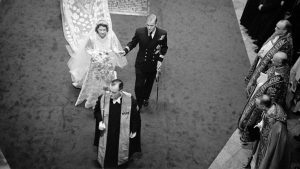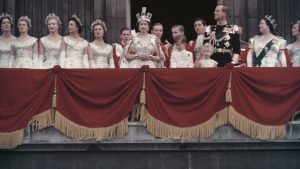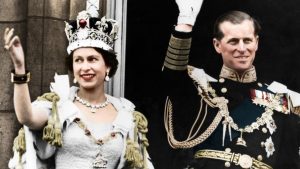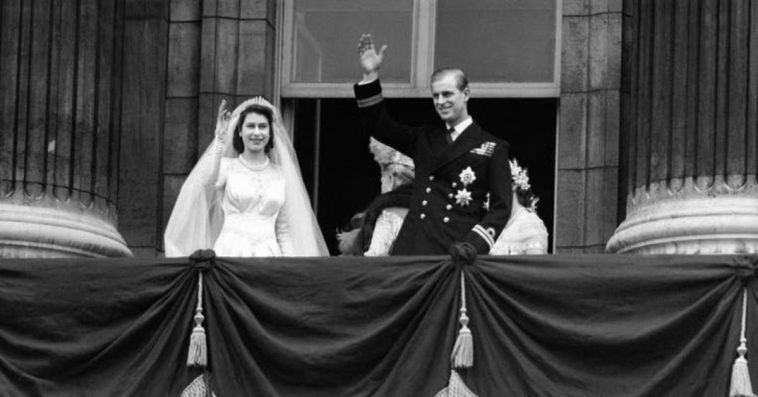Although Queen Elizabeth II held the British throne for 70 years, she wore her wedding ring even longer.
One of the longest royal romances in history ended when she parted ways with her loving husband, Prince Philip, after 74 years of marriage in April 2021.One and a half years after her husband’s passing, the Queen herself passed away on Thursday at the age of 96.
The “Prince Charming” stereotype is common in fairy tales, but for her majesty, it was a reality. The two met when they were quite young, so it wasn’t exactly love at first sight. While visiting the Britannia Royal Naval College, Princess Elizabeth, at 13, became quite obsessed with Philip, who was then the handsome young prince of Greece and Denmark.
According to Marion Crawford, who served as Elizabeth’s governess, Philip made the young princess blush in her biography “The Little Princesses.”At a 1943 Christmas play at Windsor Castle, she did get the chance to see him blush, though.
According to the Smithsonian, Elizabeth used her charm to make Philip laugh while sitting in the front row since she knew he would be there.

Photo Credits – Bert Hardy/Picture Post/Hulton Archive/Getty Images
Year after year, the two wrote to one another. They were separated throughout Philip’s World War II service, but after it was finished, he returned to London and requested Elizabeth’s hand in marriage from King George VI.
Regarding the connection, the king was hesitant. The Mountbatten family is a cadet branch of the House of Battenberg but changed that name during WWI. Philip’s heritage was German, & the allied world had been distancing itself from German lineage since World War I.
When King George [V] changed the long-lasting family name from Saxe-Coburg & Gotha about that time, even the House of Windsor, Elizabeth’s family, attempted to remove itself from its German heritage. Elizabeth and Philip share a common ancestor in Queen Victoria, who wed a German prince.
The Smithsonian reports that many people in Buckingham Palace were worried that Philip would be easily influenced by his uncle, Lord Louis Mountbatten.
But ultimately, not even the monarch could stop their love story. Elizabeth married Philip on November 20, 1947, with his approval.
The Windsors shifted their plans for the royal wedding from being a quiet, family affair to an opportunity to raise the nation’s morale, which had been severely damaged by the war. The streets of London were lined with pomp and ceremony befitting a princess. As the heiress’ carriage passed, onlookers waved the Union, Jack.
Royals from all over Europe, including the monarch of Iraq, were among the 2000 guests invited to Westminster Abbey.
Philip had given up his Greek titles by this time. Sir Philip Mountbatten, a knight of the garter but no longer a prince, was who he was. However, George VI granted the title of his royal highness to him the day before his wedding. The following day, Philip was raised to the titles of duke of Edinburgh, earl of Merioneth, and baron of Greenwich in the County of London.
In their early years of marriage, Elizabeth and Philip lived a simpler lifestyle. Philip kept up his naval career as they had already begun a family.
But when George VI died on February 6, 1952, making Elizabeth the new monarch, things got more complicated. When she learned of her father’s passing, she and Philip were in Kenya on their commonwealth tour.
George VI died of cancer at the age of just 56. In place of a lengthy and rewarding naval career, Elizabeth’s accession to the throne forced Philip into the position of royal consort, which had only been held by two other men.
The days of joining her on walks were over. With his new position, Philip was now a few steps behind his wife. He was then crowned by her, and the entire world saw him at her feet, kneeling. He committed himself to be “her liege man of life and limb, and earthly worship,” and he worked his entire life to fulfill that promise.
Former private secretary Michael Parker claimed that Philip once told him that his responsibility was “first, second, and last — was never to let her down.” Michael Parker was an old navy friend of Philip.

His wife recognized and appreciated his sacrifice by giving up his position, title, and name.
The wife typically adopts her husband’s surname name under marital rituals, before Elizabeth’s reign, that had been customarily true in British royal weddings.
For instance, Victoria was the final monarch appointed by the House of Hanover. When their son King Edward VII succeeded her in 1901, he adopted the name of the House of Saxe-Coburg and Gotha, the ancestry of her husband, Prince Albert.
Before the wedding, Philip’s uncle suggested the name House of Mountbatten, and he also considered starting the House of Edinburgh. Elizabeth’s grandmother, Queen Mary, ended that when she told Prime Minister Winston Churchill, who counseled Elizabeth against switching the royal house.

Philip worried in private about being the only guy in the nation barred from naming his children. However, the Queen had a fix for it.
Years after Mary’s passing and Churchill’s last exit from Downing Street, Elizabeth issued an order designating Mountbatten-Windsor as the last name of all of their male line descendants who are not addressed as royal highness or given the titles of prince or princess.
And in 1957, Queen gave Philip his princely title back, making him a prince of the United Kingdom this time.
The couple served as the heads of the royal house and led the monarchy through Britain’s exit from the empire and into the more agreeable commonwealth era.
They attended events together, including state dinners, foreign trips, and the state opening of parliament. Edward, Earl of Wessex, Andrew, Duke of York, Charles, Prince of Wales, and Anne, Princess Royal, were their four children.
Additionally, Elizabeth and Philip’s relationship survived despite reports in the media about their children’s failed marriages.

The Associated Press claims that Elizabeth was not a fan of excessive displays of affection. She did, however, once refer to Philip in public as her rock.
In her anniversary speech from 1997, Elizabeth praised her husband, saying, “He has, quite simply, been my strength and stay all these years. I, and his entire family, and this and many other countries, owe him a debt bigger than he would ever claim, or we shall ever know.”
Philip then spoke to the Queen in a loving manner.
The primary lesson, in his opinion, is that tolerance is the only necessary component of a successful marriage. You can believe me when I say that the Queen possesses a lot of tolerance.


